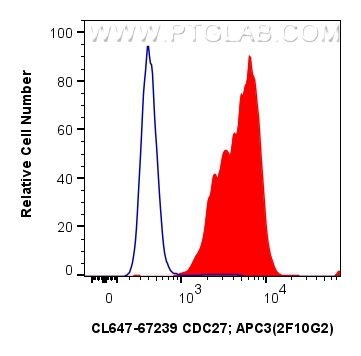验证数据展示
经过测试的应用
| Positive FC (Intra) detected in | K-562 cells |
| Positive FC detected in | K-562 cells |
推荐稀释比
| 应用 | 推荐稀释比 |
|---|---|
| Flow Cytometry (FC) (INTRA) | FC (INTRA) : 0.40 ug per 10^6 cells in a 100 µl suspension |
| Flow Cytometry (FC) | FC : 0.40 ug per 10^6 cells in a 100 µl suspension |
| It is recommended that this reagent should be titrated in each testing system to obtain optimal results. | |
| Sample-dependent, Check data in validation data gallery. | |
产品信息
CL647-67239 targets CDC27; APC3 in FC (Intra) applications and shows reactivity with Human, Mouse, Rat samples.
| 经测试应用 | FC (Intra) Application Description |
| 经测试反应性 | Human, Mouse, Rat |
| 免疫原 |
CatNo: Ag25588 Product name: Recombinant human CDC27; APC3 protein Source: e coli.-derived, PET28a Tag: 6*His Domain: 481-830 aa of BC011656 Sequence: ALCSYNCKEAINILSHLPSHHYNTGWVLCQIGRAYFELSEYMQAERIFSEVRRIENYRVEGMEIYSTTLWHLQKDVALSVLSKDLTDMDKNSPEAWCAAGNCFSLQREHDIAIKFFQRAIQVDPNYAYAYTLLGHEFVLTEELDKALACFRNAIRVNPRHYNAWYGLGMIYYKQEKFSLAEMHFQKALDINPQSSVLLCHIGVVQHALKKSEKALDTLNKAIVIDPKNPLCKFHRASVLFANEKYKSALQELEELKQIVPKESLVYFLIGKVYKKLGQTHLALMNFSWAMDLDPKGANNQIKEAIDKRYLPDDEEPITQEEQIMGTDESQESSMTDADDTQLHAAESDEF 种属同源性预测 |
| 宿主/亚型 | Mouse / IgG2b |
| 抗体类别 | Monoclonal |
| 产品类型 | Antibody |
| 全称 | cell division cycle 27 homolog (S. cerevisiae) |
| 别名 | ANAPC3, APC3, CDC27, CDC27 homolog, CDC27; APC3, CDC27Hs, D0S1430E, D17S978E, H NUC, HNUC |
| 计算分子量 | 92 kDa |
| 观测分子量 | 90-100 kDa |
| GenBank蛋白编号 | BC011656 |
| 基因名称 | CDC27 |
| Gene ID (NCBI) | 996 |
| RRID | AB_2935075 |
| 偶联类型 | CoraLite® Plus 647 Fluorescent Dye |
| 最大激发/发射波长 | 654 nm / 674 nm |
| 形式 | Liquid |
| 纯化方式 | Protein A purification |
| UNIPROT ID | P30260 |
| 储存缓冲液 | PBS with 50% glycerol, 0.05% Proclin300, 0.5% BSA, pH 7.3. |
| 储存条件 | Store at -20°C. Avoid exposure to light. Stable for one year after shipment. Aliquoting is unnecessary for -20oC storage. |
背景介绍
CDC27/APC3 is a component of the anaphase-promoting complex (APC/cyclosome), which is composed of eight subunits and highly conserved in eukaryotic cells. The APC/cyclosome complex acts as a cell cycle-regulated E3 ubiquitin ligase which mediates ubiquitination and subsequent degradation of target proteins, and lead to the progression control through mitosis and the G1 phase of the cell cycle.


